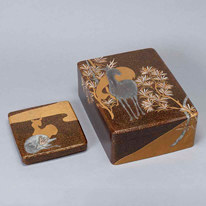Past Exhibitions
- Makie Lacquers of the Edo Period
- August 30, 2016 - October 2, 2016
Makie is a technique for decorating lacquered objects. It utilizes the adhesive qualities of sap from the Japanese lacquer (urushi) tree to affix gold and other metallic powders into pictorial designs or background patterns. Makie lacquers can be produced only by specialized, highly skilled artisans using expensive materials and painstaking processes. For this reason, such lacquers were luxury objects available only to limited members of the elite in ancient and medieval Japan. During the Edo period, however, in addition to the samurai class, there developed a new class of wealthy merchants who patronized makie artists. These merchants, who dabbled in such activities as incense games and Noh performance, commissioned makie objects that exemplified their interests and tastes. As a result, lacquers made during the Edo period exemplify a range of aesthetic tastes, including but not limited to showy works symbolizing the wealth of their owners. We hope you enjoy these jewel-like furnishings and objects made of lacquered wood with makie decoration.












